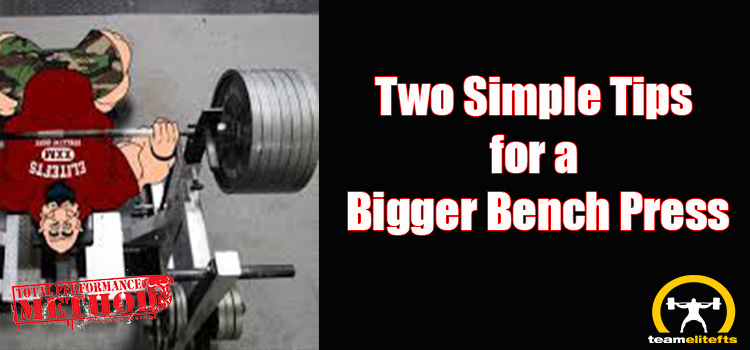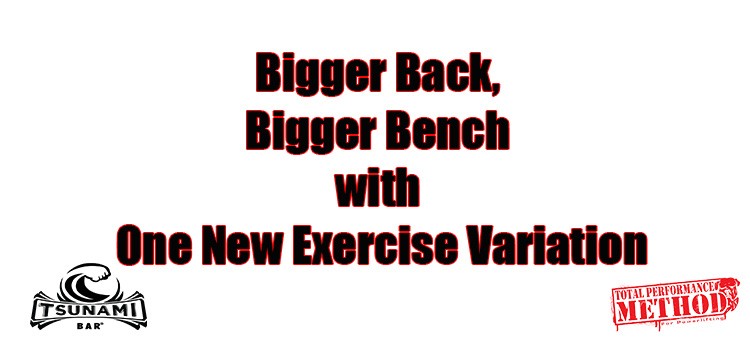
I’ve been writing about the bench press a bit lately for two reasons:
• I’m bench only now
• It’s the lift I get the most questions on
With that out of the way I’ve got Two Simple Tips for a Bigger Bench Press for you today and when I say they are simple, I mean it.
You’ve probably heard me say that the bench press is the most technical lift you can execute with a barbell and I mean it. Strength will carry you a long way on the bench, but strength paired with exceptional technique will carry you much further.
Good technique will not only keep you from getting into trouble, it may also help you recover from a minor technical mistake as well.
The first tip I have today is one to help you practice more perfectly.
We all know that practice makes perfect right?
Perfect practice is better than just practice, so……
Tip #1 for a Bigger Bench Press is for when you are doing multiple reps on your first exercise.
This could be any type of bench, board or floor press.
I see this all the time in the gym and it’s an easy one to fix.
When we do multiple reps, doubles, triples, five’s whatever, I almost always see the lifter do the first rep and then keep on going as if doing rep work like a bodybuilder.
The first rep is tight and right and then they just pump the other ones out as if to get the set over.
Or, the first rep is tight and right but the rest are loose and sloppy.
Or, the second and successive reps are started poorly, soft elbows, not locked out, back flattened out, or 100 other issues.
When coaching I instruct my lifter to perform singles.
It doesn’t matter how many reps they are doing.
If it’s a double, treat it like two singles. A triple, 3 singles and so on.
When setting up for the bench we go through a pattern of movements to get our bodies in the most optimal position for a BIG bench. This includes dragging the bar out to the correct starting position. Once we execute a rep, the bar has usually finishes behind the optimal starting position. The bar will travel up and at lockout we see it move back a little.
Most lifters start the next rep with no reset to the proper starting position for the bar and just lower it. They start from a shitty position.
Yes, I understand that lifting from less than optimal positions will make us strong(er), but that is what Specialty Exercises are for.
To get perfect practice, we must ensure that each rep begins in an optimal starting position.
So, I want you to perform one rep, stop at the top for a second and reset your position. This includes tightening your upper back, dragging the bar back out to the best starting position, and resetting your hips.
The simple act of resetting optimal position between reps will lead to more perfect practice and therefore will lead to the best technique being reinforced every rep.
What is the best starting position for most people?
Simple again.
It’s your high point.
When you set up on the bench and drag the bar out to start, find the highest point of your body and center the bar over it, or as close as you can. This shortens the range of motion allowing you to lift more.
To summarize Tip #1 for a Bigger Bench Press:
Treat all reps in a set like singles. Reset your position each time and be patient.
This is mainly for your primary exercise. On your Assistance or Accessory work, it’s ok to get after it a bit.
Just don’t get sloppy.
Tip #2 for a Bigger Bench Press (or squat and deadlift too):
This was a gift from Marc Bartley, and may be the single best tip I have ever heard for any lift.
Hold the bar for a second or two at the start of the lift and at the finish before racking it.
How many times have you seen someone CRUSH a lift and then throw it in the rack as fast as they can?
Well, I hate to tell you, this does little to ingrain proper patterns in you.
In a meet, we must wait for commands. I want you to do every lift as if you were getting commands.
What you do in training you will do under stress. The body always reverts back to training. Shitty training habits expose themselves under the worst conditions.
I know. I’ve judged countless meets and seen lifters smash PR’s and then get a red light because the threw the bar back in the rack before a rack command.
Hold that weight. Every time.
Holding the lift at the start and at lockout every time will program your nervous system to start when it is in the best position and to finish the lift completely 100% of the time too.
There is an added benefit to holding the lift at lockout after the last rep, especially the bench and it is mental as well as physical. Holding the lift as if waiting for a rack command builds mental toughness and strength.
Your brain will realize the lift is not finished until it is locked out and motionless, and your nervous system will groove that into a repetitive pattern.
Having your comp lifts be carved into your brain as a movement pattern is always a good thing!
Training your brain to finish the lift with a motionless lockout will build incredible mental toughness. At the end of a HEAVY set or a PR all you want to do is get the weight out of your hands and it it’s a PR, celebrate.
Don’t.
Hold it for a 1/1000, 2/1000 and then rack it.
Thank me, and Spud later.
To sum up Tip #2 for a Bigger Bench Press:
Unrack the weight, hold it as if waiting for a start command, when you have finished all of your reps, hold every set as if waiting for a rack command.
Did you miss last week’s log?
Oh, yeah, follow us on Instagram too.
@TPSMalden
@tpsmethod
DM ME QUESTIONS THERE TOO!
You might be featured in a Coaching Log
And @tpsmethod
SHARE THIS!
#bostonsstrongest
Vincere vel mori
C.J. Murphy
October 15, 2020











